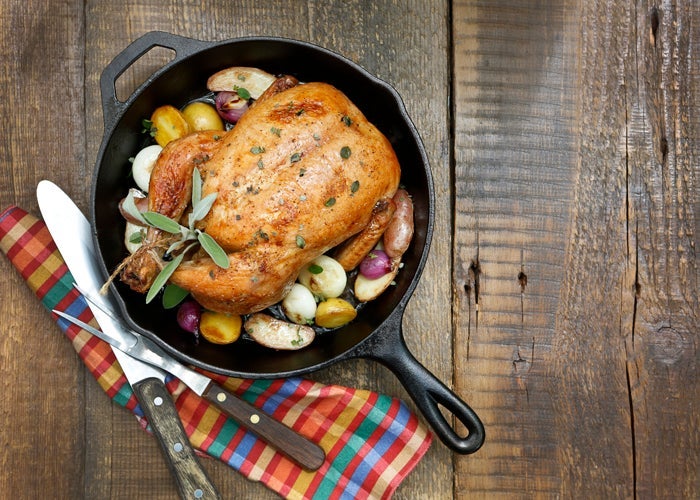The Skinny on... Chicken



If there’s one thing people cook at home, it’s chicken. We’ve gathered everything you need to know about choosing, prepping and cooking everyone’s go-to dinner.
Four tips for buying chicken
- Always purchase by weight, buying what a recipe requires.
- Check the expiration date; note whether it’s “sell by” or “use by.”
- Rely on your nose. Raw chicken should smell bright, a little bracing, and quite fresh, not sulfurous or metallic.
- The pink liquid in the package is not blood; it’s water absorbed during the chilling process, tinted by residual hemoglobin.
Types of whole chicken you might find at the grocery store
-
Broiler-fryers
About 7 weeks old, between 2 1/2 and 4 1/2 pounds. These small birds can be braised, roasted, stewed, steamed or grilled when whole; when cut up, they can also be oven-fried or sautéed.
-
Roasters
Older birds, up to 5 months, and heavier, too (between 5 and 7 pounds). These birds are best left whole and roasted, grilled or steamed.
-
Rock Cornish game hen
Really just a very small broiler-fryer that weighs between 1 and 2 pounds and is typically stuffed and roasted whole.
-
Capon
Castrated male chickens between 16 weeks and 8 months old. Normally weighing 4 to 7 pounds, they are nice roasted and appreciated for their tender meat.
|
Play it safe |
|---|
|
While the threat of contaminants can be sensationalized, a good cook takes these three precautions:
|
Chicken Labelling De-coded
Hormone-free
Buyer beware! Some companies still market their chicken as “hormone-free” but this is simply a sales tactic. The use of hormones in raising poultry has been banned in Canada since the 1960s[i].
Organic
In Canada, chicken that is sold as “organic” is raised to a standard as set by the Canadian General Standards Board, in addition to the standards set by a reputable organic certification board. It is important to keep in mind that these boards vary from province to province and there are slight differences in the rules for organic farming in different provinces. In general, to be qualified as “organic” the chickens must be raised with certified organic feed that contains no animal by-products or antibiotics.
Free-range
This term has not been legally defined in Canada or the U.S. It generally refers to poultry that has been permitted to graze or forage outdoors. Because there are no set regulations for what this means, it is best to speak with your grocer or farmer to understand what that means for their chickens.
Boneless skinless chicken breasts
Each one is more technically a “chicken breast half.” A chicken has only one breast in the barnyard — that is, the large, meaty area under the neck. In culinary parlance, it’s divided in half and becomes two “breasts” — although when left whole, both lobes together, it’s sometimes sold as a “whole breast.”
Confusing? No kidding. Still, boneless skinless chicken breasts (or breast halves) continue to be the go-to dinner for most of us. Problem is, they can be depressingly stringy — and even flavorless, since the bone adds so much taste.
The best remedy is to brine the cuts before cooking. Mix 3 tablespoons salt, preferably kosher salt, with 4 cups (1 quart) cool water in a large bowl. Add the boneless skinless chicken breasts, submerging them in the brine. Refrigerate for 30 minutes or up to 1 hour. The meat will plump considerably and can hardly be overcooked. Just omit any salt in the recipe, since the breasts will already have been salted.
Ground chicken
Everything’s been ground: skin, fat, muscle, white meat, dark meat, and even some parts you don’t want to know about.
Ground chicken meat
Only the meat has been ground, no skin or fat (or other parts), but both white and dark meat.
Recipe for Perfect Roast Chicken |
|---|
|
It’s amazing how nostalgic people can get over a roast chicken — yet how few make one. And it’s so easy! 1 Fire the oven up to 425°F. It should take about 10 minutes for a modern oven to stabilize at that temperature. In the meantime, clean the giblets and the neck from a 5- to 6-pound whole chicken. 2 Spray the skin with nonstick spray and give the bird a light coating of salt and pepper. If you’d like, pull the skin up off the breast meat and stick some herbs in the pocket you made — rosemary, oregano, or tarragon is particularly good. 3 Now set the bird on a roasting rack put into a larger roasting pan and bake for 15 minutes. 4 Drop the oven’s temperature to 350°F and continue roasting until an instant-read meat thermometer inserted into the thigh without touching bone registers 165°F, about 1 more hour. 5 Dinner’s ready! |
[i] http://www.chicken.ca/chicken-school/view/12/understanding-organic-and-other-terms
